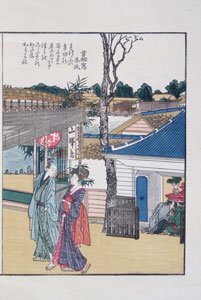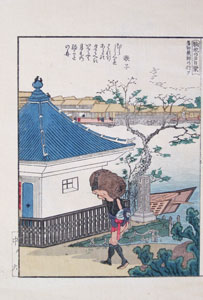Hokusai - Ehon Sumida Gawa - Prints 2-11 and 2-12

|

|

|
2-12 Flying geese above
the temple of Tada Yakushi
|
2-11 The splendor of the sunset
near the temple of Komagata
|
|

|
A man carrying a cask of sake is walking in front of Komagatadō hall where two men are praying before the statue of bodhisattva Kannon. Komagatadō (駒形堂, which literally translates into “hall with statues in the form of a poney”) refers to the representation of Kannon in the form of a horse head as it is being preserved here. The flock of geese in print 2-11 is seen flying over the temple of Tada Yakushi (多田薬師) in the Honjo district located on the east bank of the Sumida river.
According to a book chronicling the history of Sensōji temple (see print 3-1 for details), on the early morning of March 18th, 628, two fishermen, Hinokuma Hamanari and his brother Takenari, were fishing in the Sumida River. Suddenly sensing something, they pulled up their net to find a statue. When Haji no Nakatomo, village headman of Asakusa, heard about this, he immediately realized that the object was a statue of the important Buddhist deity bodhisattva Kannon. Komagatadō hall stands on the spot where this statue of bodhisattva Kannon was found - the spot that marks the origins of Sensōji temple. It is at the site of the original front gate of this temple (now Kaminarimon gate further to the north, see print 3-1).
Komagatadō hall has been repeatedly burned to the ground and reconstructed. Here are three pictures I took of Komagatadō hall in 2017 (click to enlarge):





.jpg)
.jpg)
.jpg)